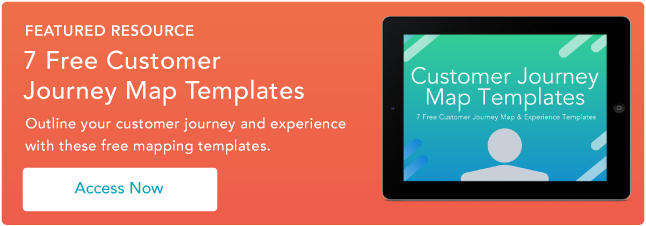What is customer experience optimization?
Customer experience is the holistic relationship that your customers have with the various customer-facing aspects of your business: customer success, customer support, your marketing blog, and your sales team. Optimization is the art of finding a balance between what your customers want more of and what your business can afford to offer.
Customer experience optimization considers each of the touchpoints within your customers’ journeys. It works to make them efficient and beneficial for the customer while not driving your business into the red. It means looking at the intricacies of a need and seeing which levers you can pull to make a difference, rather than just using a blanket strategy to try to address everything at once.
How to Optimize for Customer Experience
The best way to optimize customer experience is to first understand where your customers are coming from and then understand where they want to go. From there, build levels onto your current customer experience to bring yourself closer to what your customers are hungry for. Here are a few things that you can do today to get a better handle on your customer experience:
1. Ask customers how they feel.
It’s easy to make assumptions about customer preferences based on their actions within your product. The best thing you can do, though, is to ask them directly how they feel and what they enjoy (or don’t enjoy) about your product.
Rybbon is a great way to send surveys and conduct customer research. The results of these surveys don’t just benefit your customer experience team, either. They’re helpful for your engineering team in reporting bugs or product inadequacies, excellent for helping your marketing team understand what drives buyer behavior—and even beneficial for the product team to know what is most or least impactful for your average customer.
2. Create a journey map.
Take stock of every place your customers come in contact with your product. Document every Instagram comment, support ticket, marketing email, or ping for your sales team. Then, match up these individual points of contact with any of the data from your quantitative or qualitative surveys or data aggregation tools.
Use this information to lay out a map for the customer journey that your average customers follow. Once you understand every stop on their path and whether it positively or negatively affects their perception of your brand, you can start to optimize and improve their experience each step of the way.
3. Understand why they made their purchase.
What is the problem that your customers are trying to solve? When they pay for a product, everyone has something that they are hopeful will improve with their purchase. When you know what that goal is for your specific customers, it empowers you to move them towards it even more efficiently. The faster you get them to that realization of value, the more meaningful your product and the experience of it will be to them.
A few ways to gain these insights are:
- Talk to your support team about what customers feel frustrated or blocked by.
- Ask your customer success teams about how they measure success and what resonates with your customers.
- Discuss value drivers with your sales team — where do they find the most success in their sales cycles?
- Consult the results of your surveys. Qualitative responses are a great way to understand what your customers care about.
Optimize each step of your customer experience to drive buyers towards that realization of value.
4. Do user testing and session recording.
Products like FullStory help companies understand how actual customers behave when they are using their products. So instead of assuming that you know how your customers will use your interface, take the time to ask them and watch.
User testing and session recording are great ways to view users “in the wild” and confirm your hypotheses about how certain parts of your product impact the user journey. For instance, if no one is navigating to a specific page, despite prompts and onboarding guides designed to bring them there, it may be time to experiment with other ways to drive users there.
Similarly, this helps you see which elements of your product behave well. Use the design elements that best fit your customers’ needs to drive them forward in their journey. If you explore and understand the essential components of a user’s interactions with your product, you can redesign or emphasize the things that work best to drive business outcomes.
5. Don’t neglect mobile.
Customer experience optimization doesn’t just stop on the web. Your experience must carry through every platform that your customers are using. So, you’ll need to create responsive sites and functionality that matches those that you have on the web.
For instance, if customers can request a refund while on their computer, they should also be capable of doing so on mobile. The experience on mobile and desktop should look much the same — they shouldn’t need to wonder where to go to do things they do regularly while on their computer.
It may seem small, but it’s essential: 57% of customers won’t recommend a business with a poorly designed mobile site. Similarly, 50% of customers will stop visiting it, even if they like the company. So pay attention and optimize your mobile customer experience.
6. Emphasize consistency.
It’s not just about what you’re selling — your customers’ experience extends to your website, anything you do on social media, and even your support experience. Therefore, you must offer the same ease of experience across all touchpoints to produce the best customer experience possible.
Here are a few ways that you can provide consistency for your customers:
- Create processes that make it easy for your team members to understand where they play a role in the customer experience.
- Consider routing tickets based on skills and subject to ensure that everyone gets the best possible experience every time.
- Spend time focusing on and optimizing your phone experience — try to stay away from automation as much as possible and make it easy to get a hold of a human being.
- Task a team to manage and support your social media platforms.
Focus on the small details of each experience to optimize them, and try to make the performance match across different touchpoints.
Optimize Your Customer Experience
It takes time, energy, and knowledge of your customers to make a stellar customer experience.
Start by breaking down the customer journey and any misconceptions your team might have around how your customers feel about you. Next, send surveys to confirm your assumptions or dredge up different needs that you might not already be aware of.
From there, take time to understand your actual users’ behavior — what do they do in your product, why did they buy your product, and what are they hoping to do moving forward? Then, you can start to optimize your customer experience by making small changes to unify customer and business goals across the board.






![Is The Customer Always Right? [What It Means + Why It Matters]](https://53.fs1.hubspotusercontent-na1.net/hubfs/53/customer-is-always-right-origin-1-20250202-6448090.webp)





